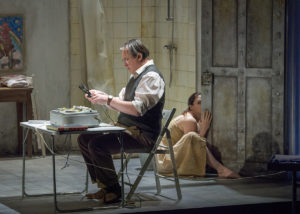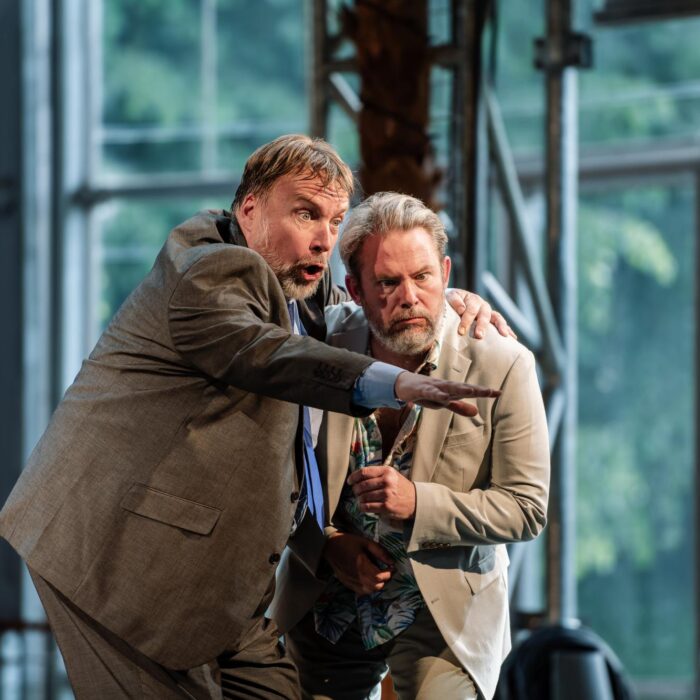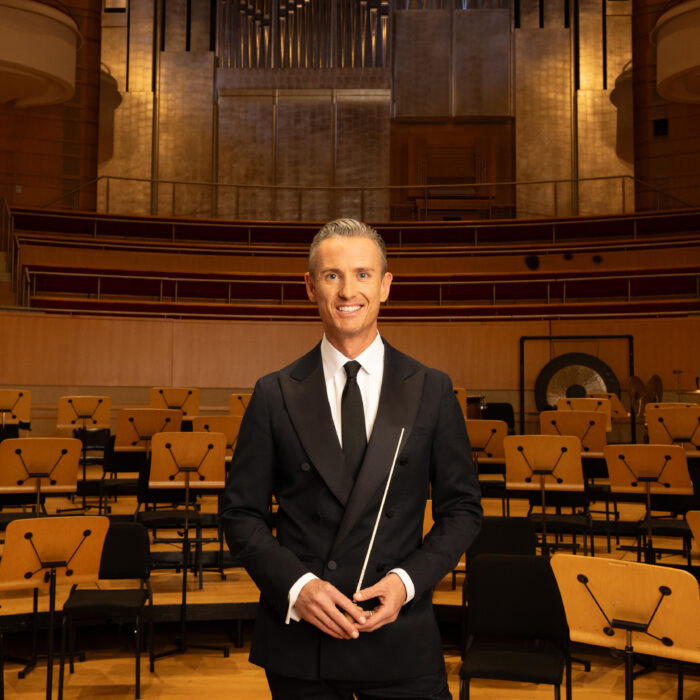
Theater Orchester Biel Solothurn 2019-20 Review: Bluebeard’s Castle
An Intimate Tale of Manipulation And Abuse
By Alan Neilson(Credit: Konstantin Nazlamov/TOBS)
The small Swiss town of Biel is home to what must be one of the world’s smallest theaters that is able to boast a regular opera season. With a seating capacity of under 300, spread over three tiers, it is an intimate space in which everyone in the audience is close to the stage. The orchestra pit is barely sufficient to host a medium sized chamber orchestra. Yet this has not prevented the Theater Orchester Biel Solothurn, under the artistic direction of Dieter Kaegi, from mounting an interesting series of works. Consisting of six productions, the current season began in September with “La Fille du Régiment” and will conclude in May with an “La Liaisons Dangereuses,” a pastiche, using the music of Vivaldi.
Currently, the theater is presenting Bartok’s “Bluebeard’s Castle.” On paper, this appears to be an ambitious undertaking, given the work’s substantial orchestral requirements. And to be honest, with the theater’s orchestral force consisting of a mere 28 players, it did have one wondering how exactly it was going to reproduce Bartok’s rich sound with its multilayered textures, let alone the dynamic contrasts and power with its climactic fortissimo passage dominating the central section, at the point when Judith opens the fifth door to reveal the Duke’s vast realm.
Such concerns, however, proved to be totally misplaced. Kaegi and the musical director Kaspar Zehnder worked together to produce a reading which used the theater’s intimate environment to their advantage, producing an intense psychological interpretation, in which Bluebeard and Judith’s relationship, founded on control, love and abuse was played out on the small stage watched over by the narrator-cum-forensic psychologist as well as the audience, who by their very closeness were drawn into their personal drama in a way which is not possible in a large theater.
The score used for the performance was the Eberhard Kloke edition, written for a much smaller orchestra, but with the vocal parts remaining unaltered. The effect was to increase the immediacy and intensity of the piece, in which the sound becomes less dense, with a thinner textural depth. This proved an ideal fit with Kaegi’s dramatic interpretation, as it increased the profile of the singers, in which their vocal lines now carried a greater amount of the musical weight, enabling them to highlight their characters with greater clarity.
A Symbolic Production
Although “Bluebeard’s Castle” is fundamentally an expressionist work which makes extensive use of symbols, Kaegi’s approach was to refocus it onto the individual psychologies of Judith and Bluebeard, whilst still using the doors as symbolic signifiers. In this case each door is an object found in their apartment which play roles in their relationship. Door two, for example, which opens into Bluebeard’s armory, is a box containing dead roses. When Judith goes to open the box, Bluebeard stamps on her hand, and is amused as she rips open her hands on the thorns. He then tenderly bandages them. Bluebeard’s behavior swings continually between abuse and apparent care. Her pain amuses and delights him. Her constant assertions of love or periods of calm send him into paroxysms of rage. Only further pain pacifies him. It is cycle which plays out across the opera, ending with Judith’s total humiliation in front of Bluebeard’s three ex-wives, who appear from behind the shower curtain, each carrying bruises from his beatings. Of course, there were oases of relief, such as when they shared a bottle of wine on the roof, looking out over his realm, which had the effect of highlighting Bluebeard’s abuse and manipulation more acutely.
Kaegi decided to retain the role of the narrator, but instead of simply delivering the spoken prologue, he played an active role in the drama as a forensic psychologist, who watched their story unfold, and listened to tapes, which in the final scene are revealed to be the confessions of the wives.
Francis O’Connor, the scenographer and costume designer, did a splendid job in creating a seedy, one room, run-down apartment in which Judith is made to spend her life. The door was kept locked. Although the stage is small, the set was imaginatively designed and versatile, rotating to allow different perspectives to be presented. When Judith opens the fourth door, for example, she looks out of a small broken window, at a garden. The audience now looking at the outside of the apartment sees her pained face pressed against the window pane, trapped, imprisoned.
It was a very powerful reading, one which cleverly exposed the power relationship at the heart of an abusive relationship. It uncovered Judith’s and Bluebeard’s deeply fractured psychologies and the pathologies which dictated their behavior. While Judith is trapped by her own dependence, for Bluebeard it is a game to be enjoyed. Towards the end, Bluebeard rests on the stairs and injects himself with a drug: a metaphor, reality or both?
Musical Intensity
Zehnder elicited a suitably forceful, energetic and acute reading from Sinfonie Orchester Biel Solothurn, which added immeasurably to the tense volatile relationship between Bluebeard and Judith, while at the same time capturing the beauty of Bartok’s music, bringing out its intensity and contrasting colors.
Bluebeard and Judith were played by bass Mischa Schelomianski and mezzo-soprano Katerina Hebelkova, and a fine pairing they made. The abusive relationship was so realistically crafted that it was painful to watch. Schelomianski gave a first-rate acting performance; the joy he felt at Judith’s suffering was etched on his face in an maniacal grin, his bouts of uncontrolled anger were frightening. Hebelkova was his equal; her pain, her love and her weakness were all compellingly portrayed. The manipulation and abuse at the heart of the relationship was brought to the fore in a menacing way, and in contrasting it with periods of calm it created a believable and nuanced picture. Before the romantic moment spent up on the roof, Bluebeard dragged Judith violently up the stairs.
Likewise, both sang well. Schelomianski gave a versatile performance; at times his voice was colored with a violent edge, at other times coated with a serene calm. The voice is strong and secure, and he displayed skill in accenting the vocal line. Hebelkova gave a strident and expressive performance, singing with emotional depth, which showed considerable vocal flexibility, taking leaps with ease, and singing in the upper register with power and quality.
The Narrator was played by Christian Manuel Oliveira. At the beginning of the evening he was sitting at a desk listening to the tapes, trying to make sense of what had happened. His sympathies clearly aroused he watched the abuse inflicted upon Judith, but try as he may he could not help her. It was a good performance, one in which Oliveira convincingly identified with the character.
This was the second performance of “Bluebeard’s Castle” I have reviewed so far this year. The two could not have been more different. The first at Venice’s La Fenice was large-scale, plush and visually extravagant. The interpretation was focused on the symbolism contained within the libretto. On the other hand, this production at Biel was intimate, small-scale and visually raw, and the symbolism was no more than device for introducing a variety of abuse. The fact it was as successful as La Fenice’s production is both a testament to the interpretative possibilities of Bartok’s opera, and to the ingenuity of Biel’s artistic team.



